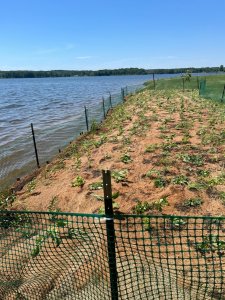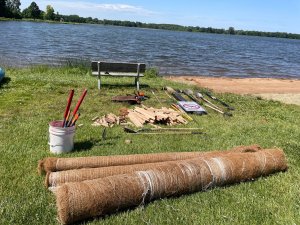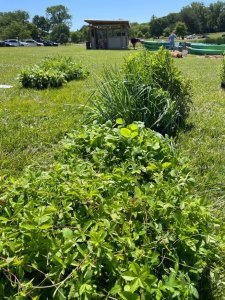Softened Shorelines, Cleaner Water for All
June 26, 2024
By Erin Parker, Interpretive Services Supervisor
Hot temperatures and sunshine mean the water is calling! Whether you head straight for the beaches for a swim, rent a paddleboard, stick to the shore for fishing, or launch a boat, summertime is peak season for water-based recreation.
Visitors to Eastwood Beach at Stony Creek may notice a small area near the kayak and paddleboard rentals that is fenced off this year. The fencing isn’t protecting against people, but rather geese. Geese, great gobbling herbivores (plant eaters) that they are, would love to taste test all the new plantings behind that fence and we’d like to give those plants a chance to grow. But what are they and why were they installed along the shoreline?

Softened shorelines, also called living shorelines, rely on a mix of plants indigenous to the place where they’ll be installed to replace hard or human-made surfaces. Along with aesthetic value, they provide food and shelter for land- and-water-based wildlife, reduce shoreline erosion, and even help to filter water running off from parking areas. The mix of taller and shorter plants, once established, can also be part of a natural goose reduction process as they typically don’t spend a lot of time in places where they don’t have clear views of their potential predators and move on the spaces with shorter grass.

The first phase of the Eastwood Beach shoreline project was done as a hands-on learning opportunity for participants in the Michigan Natural Shoreline Professional Training, that took place over two days in March and a third day in June of 2024. This gave Metroparks staff as well as 30 additional people from all over the state time to learn and then put into practice their new knowledge. The beach installation functions as a hands-on laboratory for the class participants as they work towards certification as well as an educational opportunity for the Metroparks and their visitors.
While many of the plants are planted directly on the shoreline, others can be installed in the zone where they are typically under water or partially underwater. This adds important habitat for larval fish and the small aquatic creatures that make up the bottom of the food chain in our inland lake ecosystems- feeding everything from turtles to birds to larger fish. These plants also host wading birds like herons and a variety of pollinating insects will visit the flowers in future years. This small patch will provide myriad benefits to humans, water quality, and wildlife.

According to the Metroparks’ Chief of Natural Resources and Regulatory Compliance, Katie Carlisle, “Softening or naturalizing a shoreline is a great way to reduce erosion, increase water quality, and provide space for pollinators and wildlife. For the first year, we fence off the planting in order for flowers and grasses to establish without the browse pressure from geese. After the first year, visitors can expect to see native perennial flowers that attract a variety of butterflies and birds. We hope to continue to naturalize a portion of the shoreline every year until we reach the beach!”
Softening or naturalizing some shorelines are just one of the ways your Metroparks are working to address stormwater, water quality, and wildlife habitat in southeast Michigan. For those interested in learning more about the benefits and processes of developing a living shoreline, or to learn how to become a Certified Natural Shoreline Professional, find additional resources below:
Read more about the efforts the Metroparks are taking to keep our water clean and beaches open:
Beach Management: Combating E. coli
WaterWise: Empowering Students through Stormwater Education
Parks in Partnership Highlight: Michigan Natural Shoreline Partnership
Natural Shorelines for Inland Lakes (pdf guide)
